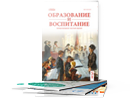The article analyses the ways gender is represented and altered in Oscar Wilde’s «The Happy Prince» translations. The research lies within the study of language and gender, a field focused on both gender expression within the language structures and linguistic behavior of men and women. Using a comparative approach of four Russian and two Kazakh translations, the paper explores different approaches that either aim to adapt the story to conservative mindset or be faithful till the end and render the challenging aspect of sexuality through translation.
Keywords: gender and language, Oscar Wilde, translation, fairy tales.
Background
The exploration of gender issues in language began in the 1970s in Europe, and was connected to the second wave of feminism In the next decade, gender entered the research in translation studies [1]. It was focused on both rendering concepts of gender across language, on misrepresentation, and visibility of women translators in history. The researchers as von Flotow [2] [3], Simon [4], and Chamberlain [5] contributed to the study of gender and translation by exploring various issues such as feminist critique of language and feminist translation, intersectionality, translation of gendered metaphors, representation of gender minorities in cultures, and so on. Therefore, this study lies within the former direction, that is, it will compare the existing translations of The Happy Prince from the gender perspective.
The Happy Prince is a fairy tale first published in 1888 as a part of The Happy Prince and Other Tales collection consisting of five short stories. It is a story of love, social issues, compassion, and tragedy. The main characters are the statue of the happy prince and the swallow, both masculine in the original version of the story. The issue is that due to different factors, the translators of the story into several languages (e.g. Russian, Spanish, Hebrew) introduced some modifications, changing the gender of the swallow into feminine in order to make the romantic line conventional. For instance, Rojas-Lizana et al [6] researched this matter based on Spanish translations and concluded that there was no censorship law in Spain at the time, so the decision to make the translated version traditional was probably rooted in translator’s personal views. The researchers proposed several possible techniques that could have been utilized to make the translation more faithful, such as changing the species of the bird or specifying the gender with a complex noun, such as male swallow. Similarly, the analysis on seventeen Hebrew translations revealed that the minority (35 %) of translations kept masculine gender of the swallow.
Concerning the Russian translations, they have also been analysed mostly on Chukovsky [7] and Sergeyev & Nuzhdin [8] translations. Zimyanina investigated different techniques used by several translations of Wilde’s fairy tales, including the Happy Prince [9]. At the same time, Rojavin [10] compared the two aforementioned translations, and found that despite the fact that Sergeyev & Nuzhdin translations render the concept of gender in a faithful to the original story way, it lacks the emotional depth and the quality of translation itself. This study adds to the previous analysis by including the recent translations of Polyak [11], Gurbanovskaya [12], Kazymova [13], and Amanzhol [14].
Russian Translations
I have compared four Russian translations made by Chukovsky (1960), Sergeyev & Nuzhdin (2003), Gurbanovskaya (2019), and Polyak (2023) amd two Kazakh translations by Kazymova (2018) and Amanzhol (2014) The summary is presented in Table 1.
Table 1
|
Source Text (English) |
Chukovsky (Russian) |
Sergeyev & Nuzhdin (Russian) |
Polyak (Russian) |
Gurbanovskaya (Russian) |
Kazymova (Kazakh) |
Amanzhol (Kazakh) |
|
Swallow, masculine |
Feminine (Ласточка) |
Masculine (Скворец) |
Feminine (Ласточка) |
Masculine (Стриж) |
Neutral Қарлығаш |
Neutral Қарлығаш |
|
Reed, feminine |
Masculine (Тростник) |
Feminine (Тростинка) |
Masculine (Тростник) |
Feminine (Тростинка) |
Neutral Қурай |
Neutral Қамыс |
|
Death, masculine |
Masculine, Смерть |
Feminine, Смерть |
Feminine Смерть |
Feminine Смерть |
Neutral өлім |
Neutral өлім |
|
Sleep, neutral |
Masculine, Сон |
Neutral, grammatically masculine, Сон |
Grammatically masculine Сон |
Grammatically masculine Сон |
Neutral ұйқы |
Neutral ұйқы |
As expected, in the earlier translation by Chukovsky, the genders of the Swallow (originally masculine) and Reed (feminine) are switched. They are also in the correlation with the grammatical gender of these words in Russian, that is, Ласточка (swallow, feminine) and Тростник (reed, masculine). Interestingly, in the part when the Swallow blames the Reed (masculine in the translation) for flirting with the wind, the grammatical gender of the wind remains masculine: ия боюсь, что он (he, masculine) очень кокетлив: заигрывает с каждым ветерком (wind, masculine) [7] — “and I am afraid that she is a coquette, for she is always flirting with the wind. Even though the pairs in this translation correspond to the traditional standards (i.e. they are both feminine+masculine), this part still demonstrates same-gender romantic communication.
As Swallow becomes feminine in the Chukovsky’s translation, the connected words were translated as feminine too: His friends (gender unknown) had gone away to Egypt six weeks before, but he had stayed behind, for he was in love with the most beautiful Reed. — «Ее подруги (friends, feminine) вот уже седьмая неделя как улетели в Египет, а она отстала от них, потому что была влюблена в гибкий красивый Тростник» [7]. Similarly in Polyak’s version the swallow becomes a feminine character, even though her translation was published in 2023.
In contrast, Sergeyev & Nuzhdin have decided to retain the initial gender of the characters by choosing synonyms (the bird of different species) for the Swallow and the Reed with the corresponding grammatical gender: Swallow (he) — Скворец (masculine), Reed (she) — Тростинка (feminine, not the the synonym, but rather diminutive form of the translation used by Chukovsky). It is also evident that in this translation a greater attention is devoted to gender: Iam going to the House of Death. Death is the brother of Sleep, is he not? — while in the source text Death is a masculine concept, in the second translation it is feminine: Яотправляюсь в Замок Смерти. Смерть — сестра (sister) Сна, правда? [8] — Death is the sister of Sleep, is she not? Death is called sister as the grammatical gender of the word is feminine. At the same time in Chukovsky’s translation: “ Я улетаю в Обитель Смерти. Смерть и Сон не родные ли братья?” [7] — Death and Sleep are brothers, despite the fact that Death is still grammatically feminine, the translator names them both “brothers”. The similar situation can be observed in Gurbanovskaya’s translation: « Смерть же сестра Сна, правда?» [12] — Death is the sister of Sleep, isn’t she? The translator aims to retrain the original gender of the swallow by translating it as a bird of a different species — a swift, which psychically resembles swallow.
The main ideas, that is, the contrast between a true, deeper love and a superficial attachment, misery and poverty of society, are still conveyed in all transitions as love is still love regardless of the gender of characters. The topics of how unfortunate people around us may be and the great gap between the wealthy and the poor of Wilde's times are not affected either by the decisions of translators concerning gender.
Still, Chukovsky was not only a translator, but a writer of stories for children. It is not difficult to predict that his interpretation of the Happy Prince was meant to be read by the young readers (because of the fairytale language) of the Soviet period, who would not understand the main message about love if the characters were of the same gender as in the source text. Moreover, such a translation may not have been permitted to publish at all at that time due to the strict censorship matters. However, Polyak’s translation was published long after the collapse of the Soviet censorship regime, and still it was performed in terms of heteronormative representation of love. This may be due to the fact that in post-Soviet countries, the matter of unconventional relationships is still being censored (the respective publishing house Foliant is based in Kazakhstan).
On the other hand, the translation of Sergeyev & Nuzhdin, which was published 43 years later after Chukovsky, both conveys the message and retains the details of the original. Taking into consideration the author’s biography, it is reasonable to expect that Wilde wanted to implicitly highlight that love is possible between the representatives of the same gender, but if it is, then the Chukovsky’s and Polyak’s translations completely lose this idea, while Sergeyev & Nuzhdin and Gurbanovskaya were right when they decided to stick with the original genders of the characters by choosing synonyms. This makes me think that If gender didn’t play such an important role in Wilde’s story, then he wouldn’t probably have assigned gender to inanimate objects, or made both pairs (Swallow and Reed, Swallow and the Statue of Prince) of the opposite or the same gender. However, Polyak has also adapted opposite-gender characters strategy despite the fact that the translation was published only two years ago. In this regard, one needs to remember that Chukovsky’s and Polyak’s translations were officially published by some prominent publishing houses in Russia (Martin, Azbuka Klassika) and Kazakhstan (Foliant), while Sergeyev & Nuzhdin and Gurbanovskaya translations were only published on online websites of journals.
Kazakh Translations
Apparently, the Kazakh translations of The Happy Prince have not been officially published by any publishing house. However, it was possible to find two online translations (Kazymova and Amanzhol) that can also be analysed. One needs to remember that Kazakh belongs to genderless languages group, which means that it does not express this concept neither in words (no grammatical gender category), nor in pronouns (such as in English). Apparently, the speakers of Kazakh would have to decide themselves the gender of the Reed and Swallow as their gender is not expressed. Though, I need to note that the direct translation of the swallow, that is, Қарлығаш is also Kazakh feminine name. Therefore, it is possible that Swallow is still associated as a woman in the Kazakh version of the story.
Apart from that, there was another aspect where the concept of gender was expressed through rather lexical than grammatical means: I am going to the House of Death. Death is the brother of Sleep, is he not? — “Өлім мен ұйқы екеуі ағайынды емес пе” [13] — The Death and the Sleep are brothers, aren’t they? Contrasting with Russian translations where Sleep and Death are sisters, Kazakh retains the gender of the original by naming the Sleep and the Death brother. The same is true for the second version of the Kazakh translation by Amanzhol.
Conclusion
It is true that gender aspects may not impact the core message of the story, which is self-sacrifice, social inequality, and unconditional and pure love. Still, the approaches considered in this article may conceal a secondary message on the possibility and acceptance of same-sex relationships. This may happen due to the resistance of the target audience to this kind of attachment which is directly connected to censorship that may be existing till the day. So far, only unofficial translations published in open access within the Internet dare to challenge this kind of perception and try to perform a faithful and a dareful to some extent translations.Apparently, Kazakh, being a genderless language, provides for broader possibilities to do so, however, the gendered concepts can retain in the lexical layer of the language.
References:
- Handbook of translation studies. Vol. 1 / ed. by Y. Gambier, L. van Doorslaer. — Amsterdam: John Benjamins Publishing Company, 2010. — ISBN 9789027203311.
- Flotow L. von. Feminist translation: Contexts, practices, theories // TTR: Traduction, Terminologie, Rédaction. — 1991. — Vol. 4, № 2. — P. 69–84.
- Flotow L. von. Translation and gender: Translating in the era of feminism. — Manchester; Ottawa: St. Jerome & University of Ottawa Press, 1997.
- Simon S. Translation and gender: The politics of cultural transmission. — London; New York: Routledge, 1996.
- Chamberlain L. Gender and the metaphorics of translation // Signs: Journal of Women in Culture and Society. — 1988. — Vol. 13, № 3. — P. 454–472.
- Rojas-Lizana S., Tolton L., Hannah E. “Kiss Me on the Lips, for I Love You” Over A Century of Heterosexism in the Spanish Translation of Oscar Wilde // International Journal of Comparative Literature and Translation Studies. — 2018. — Vol. 6, № 2. — P. 9. — DOI: 10.7575/aiac.ijclts.v.6n.2p.9.
- Уайльд О. Счастливый принц [Электронный ресурс] // Нукадети. — URL: https://nukadeti.ru/skazki/schastlivyj-princ (дата обращения: 4.04.2025).
- Wilde O. The Happy Prince [Электронный ресурс] // Lib.ru. — URL: https://lib.ru/WILDE/prince.txt_with-big-pictures.html (дата обращения: 4.04.2025).
- Zimyanina V. N. Translation of Oscar Wilde’s literary fairy tales and the problem of their adaptation to another culture // Polylinguality and Transcultural Practices. — 2015. — № 5. — P. 349–353.
- Rojavin M. If the Swallow Made the Prince Happy: Translating Wilde into Russian // The Slavic and East European Journal. — 2014. — Vol. 58, № 1. — P. 76–92. — URL: http://www.jstor.org/stable/44739651 (дата обращения: 4.04.2025).
- Уайльд О. Счастливый принц и две другие сказки / пер. с англ. — Астана: Фолиант, 2023.
- Уайльд О. Счастливый принц [Электронный ресурс] // Samlib.ru. — URL: https://samlib.ru/l/lus/prinzip.shtml (дата обращения: 3.04.2025).
- Уайльд О. Бақытты ханзада [Электронный ресурс] // Qazaquni.kz. — 2018. — 25 декабря. — URL: https://qazaquni.kz/adebiet/85109-oskar-wajld-baqytty-hanzada (дата обращения: 4.04.2025).
- Уайльд О. Бақытты ханзада [Электронный ресурс] // Massaget.kz. — URL:https://massaget.kz/audarma/oskar-uayld-bakyittyi-hanzada--16889/ (дата обращения: 4.04.2025).







